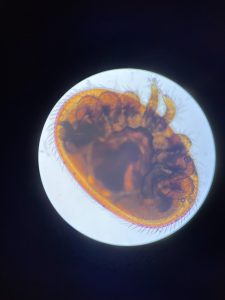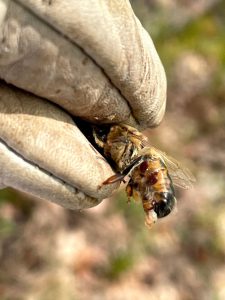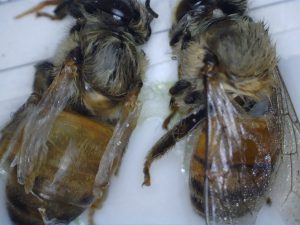
There are multiple problems that can harm the Western Honeybees. These problems can include a lack of resources such as flowers, harsh weather conditions, diseases, inadequate use of pesticides, and pest infestations such as Small Hive Beetles, Wax Moths, and Varroa Mites. Out of all these problems, Varroa Mites (Varroa Destructor) is the world’s most devastating pest of the Western Honeybees. These pests are found everywhere in the USA (except for Hawaii), which makes them a big concern for beekeepers and small farmers that rely on bee pollination to boost their crop yield.
What is that red thing on my bees?
Varroa Mites are very small but can be seen with the naked eye hitchhiking on adult worker bees and drones. The adults are about 1.2 mm in size, flat oval-shaped, and reddish/brown in color. Female mites are larger than males. Varroa mites have a gradual metamorphosis. This means that the nymphs look like smaller versions of the adults. They have claws that allow them to remain attached to the host bee even during flight. You can observe them on top of immature or mature bees (Specially drones). However, they are difficult to spot and since they are flat, they can fit inside the abdominal segments of bees, which means beekeepers may have them present in their beehives without being aware.

Feeding habits and spreading germs
Varroa mites are natural ectoparasites of the honeybees (live on the outside of the body of their hosts) and have a piercing-sucking mouthparts. This pest feed on the fat bodies of immature and mature bees harming the bees in the process and transmitting viruses that affect the development of young bees.
A sticky situation inside the hive
An infected bee will bring an adult female mite into an uncap brood cell where an immature bee (Larva) is developing. The female mite will lay eggs in this cell once it is cap, and these offspring will mate among themselves when reaching adulthood (in about 6-8 days). When the new bee emerges from the cell, the female mites will emerge attached to this bee while the males remain in the brood and die. When this new bee has contact with other bees in the colony the mites spread, and the cycle repeats itself.

Varroa mites basically “suck”
Varroa mites are not likely to kill adult bees, but they can shorten their lifespan. On the other hand, they can kill immature bees affecting the integrity of the whole colony. Immature bees are less likely to develop into an adult in severe infested colonies. Fewer worker bees means fewer resources collected, which leads to weakening of beehives. If not addressed appropriately, mite infestations will lead to the destruction of the whole colony. They can also spread to nearby hives, so it is important to identify what colonies are affected to protect the ones that are healthy. Furthermore, Varroa Mites are vectors of diseases. One of the diseases is the Deform Wing Virus, which as the name implies, new emerged bees are typically found with deformities in their wings and not able to fly.
Managing against Varroa destructor
There are different ways we can use to manage Varroa mites:
- Preventive measures – The easiest and most important way of control is making sure your bee colonies are healthy and strong. Healthy hives are less likely to have serious infestation with Varroa mites. When food sources are scarce (especially during the winter months) make sure to provide additional food sources to avoid the weakening of your hives.
- Invest in hygienic bees – Genetics also plays an important role controlling mite populations. Highly hygienic behavior among colonies is important to maintain low amounts of mites inside the hive. Replacing a queen with bad hygienic behavior with one that has good genetics can help control the Varroa mite populations.
- Develop a surveillance program – It is important to monitor Varroa mite’s populations for better control. The use of a screen at the bottom of the brood box will help you maintain any fallen mite outside of your hive. Also, if you add a sticky board in combination with the screen, it will help you monitor the pest population. Another method for monitoring mite populations is to perform an alcohol wash. If you wish to know more about how an alcohol wash is done and how it can help with your hives, access the following video https://youtu.be/g0-igXeNv4Y.

A bee presenting Deform Wing Virus symptoms (Left) transmitted by Varroa mites vs. a healthy bee (right). Picture credit: Jonael Bosques, UF/IFAS Extension - A good offense: treatment options – Chemical control has been traditionally the most effective way to manage Varroa mites. Mites are not insects, so there are multiples pesticides that are able to control the mites without harming the honeybees. Using pesticides such as sticky screens, strips, trays, vaporizers, and other chemical formulations can be an effective way to control mite populations. It is important to follow label instruction each time you use pesticides.
For further Information
If you would like to learn more about apiculture, small farm pests and diseases, or production topics, please contact us at UF/IFAS Extension Polk County by calling 863-519-1049, send me an email at lrodriguezrosado@ufl.edu, or follow us in Facebook www.facebook.com/PolkExtension. UF/IFAS Extension provides solutions for your small farm or agricultural operation.
University of Florida is an equal opportunity institution
 0
0

